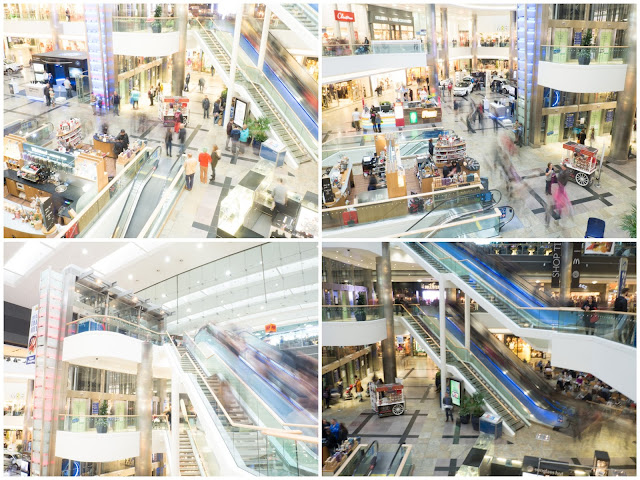For my third photo shoot I wanted to capture time and its relationship with motion in a different way. Inspired by Haas pioneering photography and by the Futurism art movement I wanted to move on form the static depiction of motion and start representing movement and periods of time using long exposures and slow shutter speed. By doing that I wanted to create abstract blurs that give a sensation of speed, dynamism, energy, noise, force, motion and time flowing.
 |
| From my sketchbook |
Choosing the locations for my third photoshoot I decided to capture large groups of people moving. Therefore I've decided to shoot at the West Quay shopping centre in Southampton and in the busy streets of central London.
 |
| From my sketchbook |
My first shooting location was the shopping centre in Southampton. I fixed my camera with the Gorilla Pod (flexible tripod) at the first floor directed to the busy stairs. I used long exposure - ranging from 1 to 5 seconds of shutter speed - to capture the flow of people going up and down stairs. To achieve correct exposure I used ISO 200 setting and the narrowest aperture possible (f 22). Shooting in RAW meant that modifying exposure could be easy and without any substantial image-quality degradation. In post production on Lightroom on my best picture I used VSCO 07 filters, specifically the Kodak 50 Ultra II to recreate the popping colors and contrasty look typical of Haas' photos of the time.
 |

In these pictures the blurs give a sensation of noise, caos and busyness. The flow of people in discrete directions is emphasized by the fixed background in focus. That's achieved using a tripod, which eliminates camera shake during the exposition. The sharp blur of people descending the stairs gives a strong sense of speed and dynamism.
 |
| Contact Sheet |
For my second location I went in the busy streets of London in Oxford Circus and Piccadilly Circus. The pictures I've taken in Southampton, mainly due to the overall focus of the composition, don't look abstract or painting-like. Because of that in London I experimented with the second technique of Ernst Haas' photos to capture motion in an abstract way: moving the camera during exposure. Therefore I decided to try not using the tripod to achieve the desired effect. In the first pictures I simply started capturing cars or people crossing the streets. Using long exposure - and balancing ISOs and aperture - the subjects leave a light and ghostly blur:
I then moved in front of the underground entrance to capture a more dense group of people moving. Using long exposure and camera shake I was able to create an abstract composition, where different blur and different shapes of different colors sinuously mix. I think I achieved the effect desired: a painting-like abstract photo that depicts shifting time and continuos motion. To recreate the colors of Ernst Haas' photos I used Kodak filters with popping colors and high contrast in Lightroom, here too.
I then continued photographing people walking in front of stores and in the underground using this time the tripod and experimenting with different shutters speeds. As the light began to diminish and the sun started sunsetting the lights of cars and buses began producing light trails in the pictures, another famous effect achievable with long exposure photography.

Going back home I took this picture in the underground. The strong leading lines of the composition, the symmetry and the depth emphasize the sense of motion, speed and dynamism of the blurred motion. These characteristics are also emphasized by the fixed and in focus background and location.
 |
| Contact Sheet |







